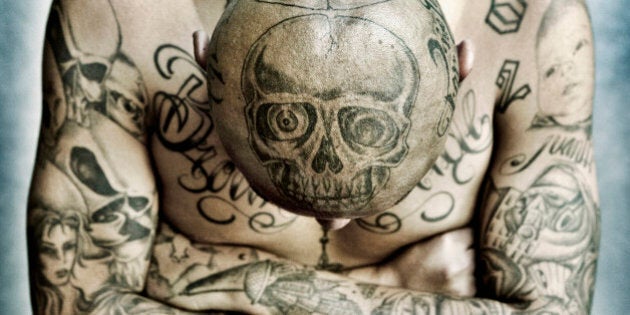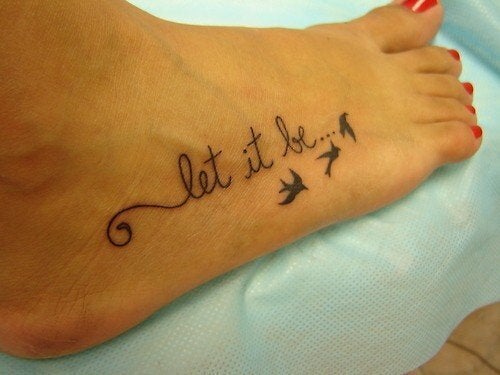
Having a tattoo like that is like wearing a blouse you can never wash, a friend of mine remarked. She said this after noting the technicolor wrist-to-shoulder arm and full leg tattoo that our mini-skirted waitress was sporting. I liked the waitress' body art but like my friend I have been noticing that tattoos seem to be exploding from the once small and private to in-your-face, almost full body art.
As someone who tires easily of her surroundings and finds the need to recover chairs and sofas every two years, I am always struck by the permanence of tattoos. Tramp stamps, tribal tattoos, your first teen boyfriend: How can you possibly live with the same skin art for the rest of your life?
Well, as tattoos become more popular we are beginning to know the answer. You cannot.
While it's estimated that in North American over half of all women and nearly half of men between the ages of 18 and 45 have tattoos, according to Toronto's Dr. Sean Rice there's been up to a 400 per cent increase in the last two years of people wanting their tattoo removed -- or if not removed, faded. "Say you had a tattoo put on 20 years ago when you were 20 and you had a character that, at age 40, you felt looked kind of stupid -- well, you can have that tattoo faded and a new one drawn on top."
Celebs have taken the lead when it comes to relationship removal tattoos. Angelina Jolie had her declaration of love for ex Billy Bob Thornton replaced with the birth co-ordinates of her kids who were born in Cambodia, Vietnam, Ethiopia, Namibia and France. Johnny Depp made tattoo-removal history when he cleverly had lasered two letters from "Winona Forever" (a tattoo in honour of then girlfriend Winona Ryder) to "Wino Forever."
In the old days tattoos used to be surgically removed, but in the last two decades laser removal has become the de-inking choice. Still, as countless YouTube videos have shown, having a tattoo lasered off has been neither pretty nor without pain or scarring. As Kelly Osbourne told her Twitter followers just before having her first laser a few years back: "It's going to burn like the snap of 1,000 rubber bands!"
But all that may be changing, says Dr. Rice, a cosmetic surgeon whose clinic is a training centre for new technologies. As they move through the laser revolution, he and a few other plastic surgeons are ditching the old Q-switched lasers they used for de-inking in favour of something called the PicoSure laser. Unlike traditional Q-switched lasers which pulse a billionth of a second, this laser delivers ultra-short bursts of energy to the skin in a trillionth of a second. While the old lasers broke down pigments like a rock can shatter into pebbles, the newest laser breaks down the pigment into particles similar to dust rather than pebbles.
One problem with the original lasers was that the light created a significant amount of heat, Dr. Rice told me. And even with the later-generation lasers, there was still pain and blistering. "The PicoSure is a hundred times quicker than (its predecessor) so it's almost like a mechanical shock wave with very little heat generated. The pain factor is like night and day."
This laser's massive shock wave smashes a tattoo into little particles that your immune system picks up, he explains. The particles get processed through the liver and "you eventually pee and poop them out." PicoSure has also been successful on brown spots, and Dr. Rice tried it on himself to resurface and rejuvinate his face. "Because little heat is generated, you are red for an hour or so but two hours later, you have no redness and there is no blistering or crusting as there are with traditional lasers."
Apparently, this new technology can remove tattoos in half the number of sessions as any other laser.
But Dr. Rice cautions that even with this laser, removal takes several treatments: "No tattoo can ever be removed in a single session." That said, professional tattoo artists are keen on this laser because it effectively removes black ink better than conventional lasers. "Often bored with their old tattoos, they want effective treatment so they can put on new ones," he says.
These new treatments may be less time-consuming and less painful, but they are still expensive. Dr. Rice estimates that a tattoo the size of a business card costs between $400 and $450 per session but that the number of treatments are half as many as with the lasers previously used. So like tattoos themselves, tattoo removal has become a coming of age thing: "In first year university, a tattoo is a cool statement, but then when you've graduated and are looking for a job your potential employer looks at the strange star on your wrist and that's when you think, 'Maybe it's time to get rid of this.'"
ALSO ON HUFFPOST:
